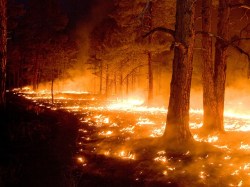
Gila National ForestLast year’s Whitewater Baldy Complex fire was the largest in New Mexico’s history, but we can expect worse to come.
The fire that burned through Forest Canyon, a breathtaking stretch of wilderness ringed by snowy peaks in Rocky Mountain National Park, Colo., started in October and burned long past the end of the fire season. Trees still smoldered in late December, and the smoke mixed with dry snow blowing in the air. Known as the Fern Lake Fire, the blaze tore through 3,500 acres of land the federal government set aside a century ago both to provide public enjoyment and protect it from human destruction.
One of those missions has been accomplished: 3.1 million people visit the park each year. Increasingly, however, the destruction it was meant to prevent is encroaching. Like most wildfires, the Fern Lake Fire was the work of careless individuals. Most likely campers let an illegal campfire get out of control. But science suggests our collective effort may have made it much worse.
Last year was the hottest on record in the United States, and the fall weather was unseasonably warm in the Rockies. The forest was weakened by prolonged drought; that November was the driest ever recorded in the park. An epidemic of bark beetles, which thrive in warmer conditions, was already in the process of killing off thousands of trees. The area’s first heavy snow came unusually late, in mid-December, and only then did the fire slow down.
Jason Sibold, a geographer who studies forest fires at Colorado State University and who has spent time exploring the canyon where the fire started, says scientists can’t say for sure that global warming was a direct cause. Pinning one extreme event to climate change is impossible to do. “But that Forest Canyon site, I never thought I was going to see that burn, much less in December,” he said. “That’s just shocking.”
Wildfires can be a good thing. They are nature’s way of cleaning house — clearing out old trees and underbrush and allowing new trees to grow and thrive. There hadn’t been a fire in Forest Canyon in 800 years. In terms of number of fires, 2012 was a low in the U.S. But it was a record high for the number of acres burned: 9.2 million. Since 1960, when the National Interagency Fire Center began keeping records, only in 2006 and 2007 have more than 9 million acres of American land burned.
In his inauguration speech this week, President Obama suggested climate change is largely to blame: “Some may still deny the overwhelming judgment of science, but none can avoid the devastating impact of raging fires, and crippling drought, and more powerful storms.”
Like the hurricane season, statistics suggest the burn season is becoming longer and more severe. A recent study of fires on U.S. Forest Service land by Climate Central, a nonprofit research group that reports on the impacts of global warming, found “the first wildfires of the year are starting earlier and the last fires of the year are starting later, making typical fire years 75 days longer now than they were 40 years ago.” Compared to the 1970s, the number of fires covering more than 10,000 acres has increased sevenfold. At the same time, a study published in the science journal Nature Climate Change in September predicted that by the 2050s, forests will experience the worst droughts in 1,000 years.
The result will likely be more fires, but also more beetles, and more trees that just can’t stand the heat. Soon, the landscape of the American West may be unrecognizable. In some cases, trees will regrow, although probably in sparser patches. Some may be replaced by different species. But especially in drier, hotter areas like New Mexico and Arizona, the forests are on course to disappear altogether.
“We’re seeing particularly here in the Southwest that we’re not getting trees back in some of these spots,” said Craig Allen, a New Mexico-based ecologist who studies landscape change. “By mid-century, it’s hard to see how the current dominant trees are going to be able to continue to grow in these sites. The climate will have changed too much.”
The Fern Lake Fire’s destruction reached as far as Moraine Park, a grassy valley carved by glaciers that’s a feeding ground for elk, a couple miles from the fire’s origin and close enough to the nearby town of Estes Park that hundreds of people had to be evacuated from their homes. Now, blackened stalks stick up from patches of snow. In some spots the charred ground lies exposed to the sky. The fire torched the trunks of a grove of aspen trees already damaged by elk antlers (the elk have run rampant in the park since the decline of predators like wolves). The upper branches are unscathed, but it’s unclear if the trees will survive.
A trail at the end of the valley follows a swift mountain stream up to Fern Lake. It also passes the southern end of the canyon where the fire began, and is the likely route of the campers who started the blaze. On New Year’s Eve, the air was frigid and there were several inches of snow on the ground, but the smoke still lingered, making it more difficult to breathe in the thin air at more than 8,000 feet above sea level. After two miles, it was possible to see the bald patches on the mountains that mark the route the fire took. The fire began near the dense, wooded floor of Forest Canyon and blew to the top of the ridge. Then it went south, across the river and along another ridge to Moraine Park. Along its path, blackened, skeletal remains of pine trees stood silhouetted against the white snow.
At first glance, it was hard to tell which trees were burnt and which were already dead from the beetles, which burrow into a tree and kill it from the inside out. A few trees were still sending plumes of white smoke into the air. A crew of four firefighters on staff with the national park had been dispatched to check on remaining hot spots. After hiking in to take a look, they said they weren’t worried the fire would restart — as long as it snows again soon.
Maybe it will snow heavily this winter, and it’s possible the fire was just a freak event. “Cause and effect with global climate is hard. … Change is a part of nature,” said Ben Bobowski, the chief of resource stewardship for Rocky Mountain National Park. But, he added, “This has never happened in our history.”
It’s the growing list of never-before-seen events like the Fern Lake Fire that’s worrisome, and that has contributed to the consensus that humans, not nature, are behind the catastrophes. In New Mexico, a huge burn that destroyed more than 350 square miles of forests last summer was the largest in the state’s history. In Australia, tens of thousands of acres are now burning in the wake of record-breaking temperatures. Beetles have consumed Western forests on an unprecedented scale. And a study [PDF] co-authored by Craig Allen in 2010 found recent examples “of extensive forest die‐off in all major forest types worldwide, from tropical rainforests in the Amazon to African savannas and Mediterranean pine forests to boreal forests in Canada and Alaska,” all because of drought and heat potentially connected to the changing climate.
Climate change can’t take all the blame for the severity of the fires or the other problems forests are facing in the U.S. and around the world. But here at least, much of the blame can be pegged to other kinds of human activity. A bad year for fires in 1879 laid waste to huge swaths of American forest — thanks to a drought, but also to the ongoing efforts of settlers burning off forest to make way for homes and agriculture. As Teddy Roosevelt put it several years later, when he was pushing for better conservation of the nation’s natural resources, “The time has come to inquire seriously what will happen when our forests are gone.”
The trees grew back, but the destruction led to extensive areas predominated by same-age trees, which are now just the right size for a beetle attack, according to Sibold. In the 1900s, Americans swung in the opposite direction. They became overprotective of their forests and suppressed many fires, which allowed fuel to build up and made conditions ripe for more extreme burns now.
The scientists don’t like to characterize the changes to the Western scenery as “bad.” Many prefer to stay neutral with words like “different” and “unique.” But when pressed, they sound concerned, and gloomy. “We haven’t had landscapes like this,” Sibold said. “You have all of these things interacting, and it’s generally not good news if you’re a tree in Colorado.”
 This story was produced by The Atlantic as part of the Climate Desk collaboration.
This story was produced by The Atlantic as part of the Climate Desk collaboration.


